Blog & Articles
Your ultimate ressource for the creator economy
Methodology & Rankings
About Favikon, rankings, tools & much more.
Insights
The recipe behind Favikon's viral & coveted rankings.
Free tools to power your influencer marketing workflows.
See Favikon users' success stories.
Get access to all Favikon rankings.
Become a Partner
Become an Affiliate
About the team behind Favikon
The place to talk creator economy, together


Featured Rankings

Here is the Top 50 Rising Video Creators on LinkedIn. Video is quickly becoming the platform’s most powerful format, with creators gaining more reach and engagement than ever. As Gen Z grows its presence and tools like BrandLink and Thought Leader Ads support content creation, LinkedIn is doubling down on video. This ranking, made in partnership with OpusClip, celebrates the creators leading this shift and aims to inspire anyone ready to start sharing through video.

Here is the Top 50 Rising Video Creators on LinkedIn. Video is quickly becoming the platform’s most powerful format, with creators gaining more reach and engagement than ever. As Gen Z grows its presence and tools like BrandLink and Thought Leader Ads support content creation, LinkedIn is doubling down on video. This ranking, made in partnership with OpusClip, celebrates the creators leading this shift and aims to inspire anyone ready to start sharing through video.


Megan Mahoney is an influencer marketer who uses data and real-world case studies to uncover what actually drives results in influencer campaigns. With a background in content marketing and over a decade of experience helping brands grow through strategy and storytelling, she brings a thoughtful perspective to creator partnerships and is deeply engaged in the evolving creator economy.
Check Brand DealsHow to Measure Influencer Marketing (For B2B Brands)
B2B influencer marketing campaigns are notoriously difficult to measure because the buyer journey is often several weeks or months, and only a small percentage of the ideal audience is in-market at any given time.
Unlike DTC influencer marketing, you can’t just offer a discount code and measure the efficacy of that influencer campaign based on the sales or demos booked the following week.
However, your finance department probably isn’t going to grant budget for an influencer marketing program with no trackable ROI.
In this post, we’ll discuss different metrics you can track to measure the efficacy of your B2B influencer marketing efforts and how to use them together to gauge the general impact of your influencer program.
The Challenges of Measuring Influencer Marketing ROI For B2B Brands
B2B buyers won’t immediately convert like a DTC buyer, but influencer marketing is often a critical touchpoint in the buyer's journey.
Therefore, it's tempting to just use impressions as the sole success metric, given that impressions are the most accurate measurement of buyer touchpoints.
However, Sarah Adam of Wix has data to prove that impressions don’t always tell the full story, and the quality of impressions still matters.
In this chart that Sarah showed, you’ll see that coupon code usage did not correlate with views:

Alex Llull of Perspective shared a similar story:
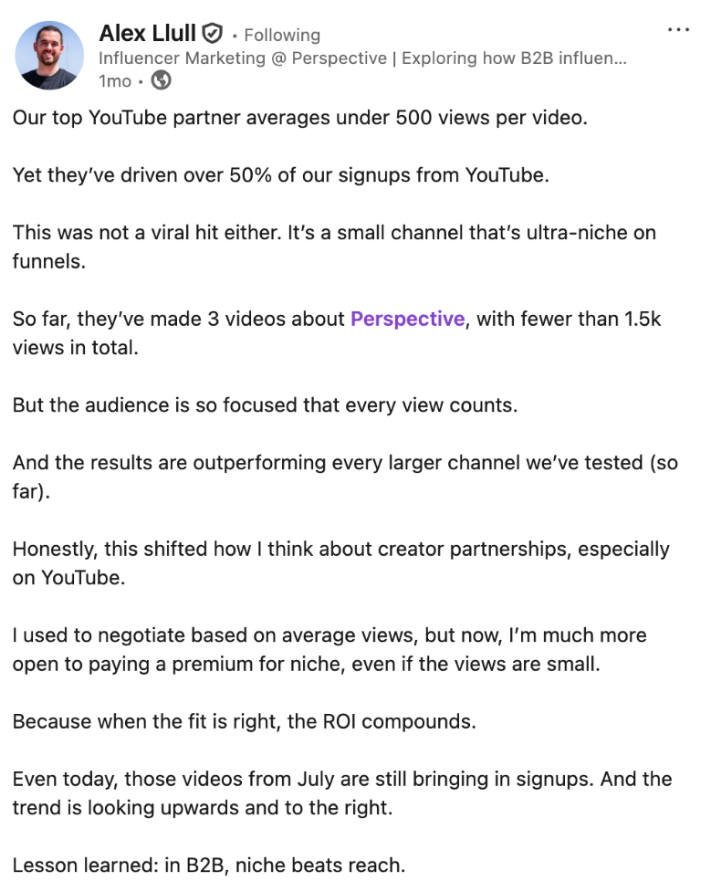
Madhav Bhandari of Storylane was also very open about the challenges of measuring the ROI of influencer marketing.
In a post, he mentioned that their influencer program generated over 700,000 impressions:

But when asked about how much ROI those impressions actually generated, he was quite honest about the complexities of measuring revenue from influencer marketing:
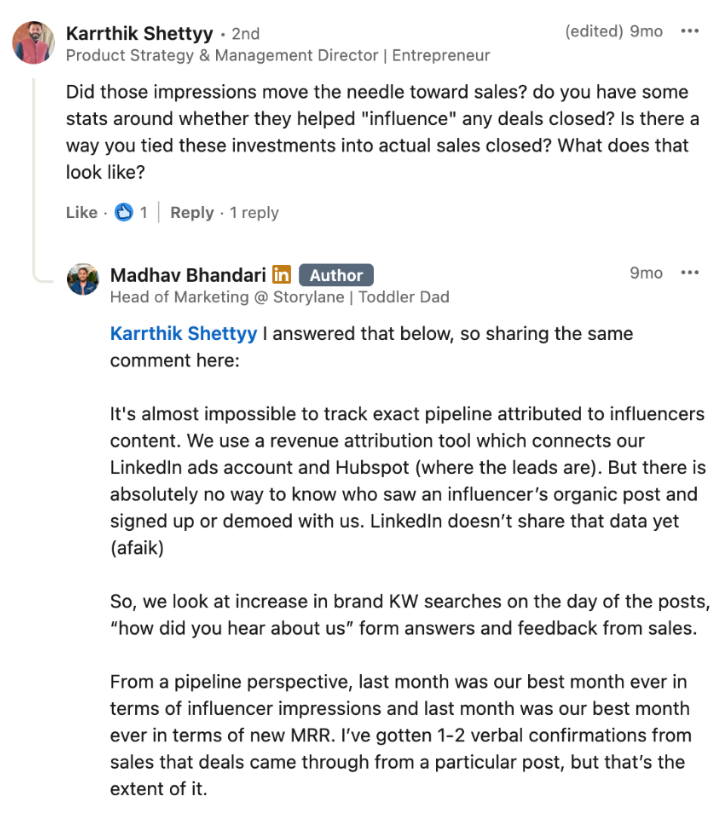
While there may not be a perfect solution for measuring influencer marketing, I believe the answer lies in measuring multiple metrics and using a combination of these metrics as a signal to better understand the impact of your influencer marketing efforts and make adjustments accordingly.
6 Metrics To Measure Influencer Marketing ROI For B2B Brands
Below, I’ll discuss six essential metrics you can use to measure the efficacy of your influencer marketing efforts.
My recommendation is to use a combination of these metrics to build an overview of the efficacy of each influencer and campaign.
Impressions/Views and Engagement
For most of the influencer marketers I talked to, influencer marketing is primarily a brand awareness play.
So impressions/views and total engagement is a logical metric as it gives you a sense of how many people saw the sponsored post.
If you’re running campaigns on LinkedIn, you can just ask the creator to send you a screenshot of the total impressions and the engagement count is publicly available.

If you’re running campaigns on YouTube, the views and engagement counts are publicly available, though you can also use a social media tool to gather the data for you.

Sarah Adam of Wix says she uses a tool called ScrapyMonster to gather all of her engagement metrics in one place.

However, the challenge isn’t just getting more views or impressions. The real challenge is getting more of the right views, profitably.
Therefore, CPM (cost per thousand impressions) and CPV (cost per view) are essential KPIs to track how much you paid for that reach.
For example, Storylane’s Head of Marketing cited CPM as a key metric they use to measure their influencer marketing success in this detailed budget breakdown post:

Marc Richards of OBVIOUS also cited CPM as the first metric they use to measure influencer marketing, along with several other more detailed metrics:
- CPM (Cost per impressions)
- CPC (Cost per clicks)
- CPL (Cost per leads)
- CTL (Cost per qualified traffic)
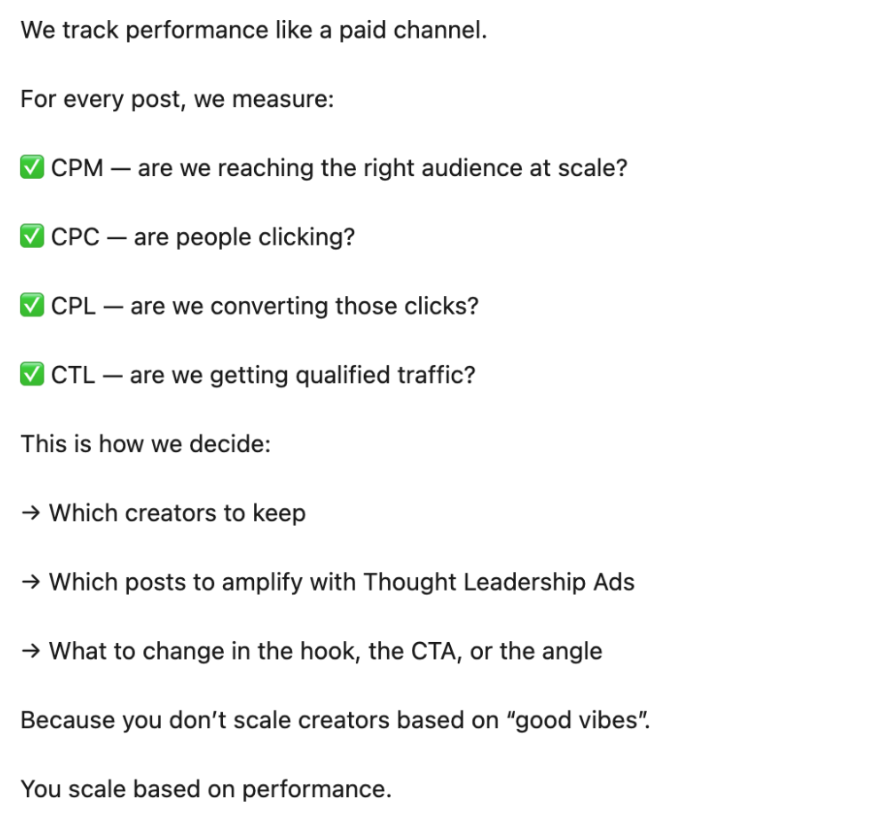
To calculate LinkedIn CPMs, take the total cost, divide it by the total impression count, and then multiply that by 1,000.
That’s your CPM.

For example, if you paid $100 for a campaign that generated 2,000 impressions, your CPM would be $50.
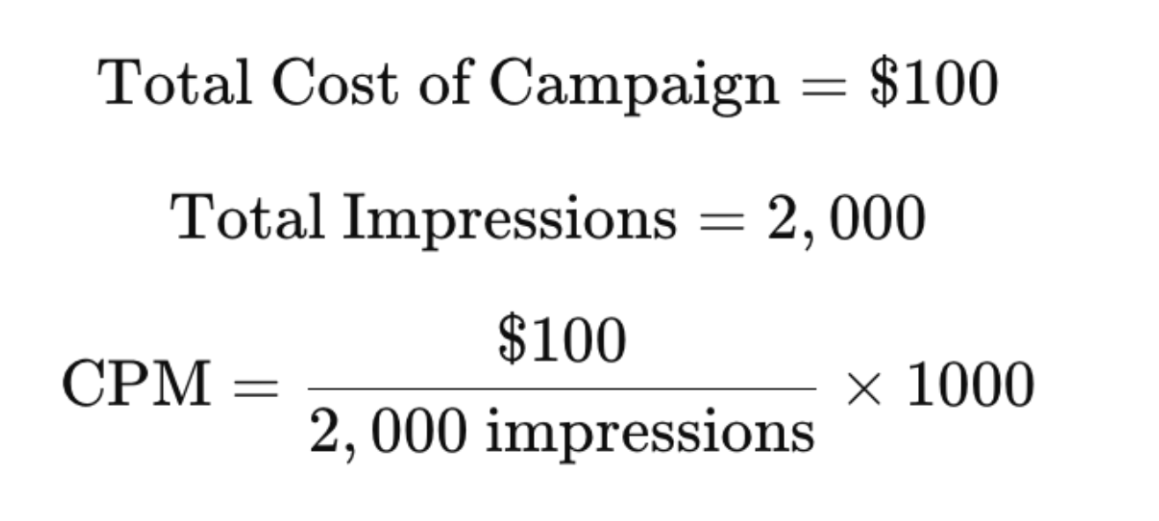
If you’re running YouTube campaigns and need to figure out the CPV, you can simply look at the total view count on the video:

Then, divide how much you paid for the video by the number of views it earned.
This is a metric Sarah Adam uses when negotiating creator pricing, though it can also be a useful KPI:
However, keep in mind that CPV doesn’t take into account:
- Whether it was a dedicated video or integration
- Exclusivity length
- Content usage rights
These factors all impact your CPV, and this is why it’s important to use multiple metrics to measure the overall success of your influencer marketing program.
Audience Quality
Impressions and view counts help you understand approximately how many people saw your content, but it doesn’t tell you if the right people (i.e., your Ideal Customer Profile, or ICP) saw your content.
This is why audience quality is also an important metric to consider.
If you’re running LinkedIn influencer marketing campaigns, it does provide some audience details, including:
- Seniority
- Location
- Companies
- Industry
- Company Size




This granular level of detail makes LinkedIn an excellent tool for tracking influencer marketing performance, as most other platforms don’t provide this level of detail.
You can take all of this data, ask ChatGPT to analyze it and dump it into a spreadsheet. This will help you better understand exactly who you reached with your campaign.
YouTube provides a general overview of demographics, such as country, gender, and age, but that’s it.

To gauge audience quality more effectively, look at the comments.
For example, if you’re trying to reach new Airbnb owners, the comments clearly show that this creator has your ideal audience:

Surveys
Almost all of the influencer marketers we’ve spoken with use a “how did you hear about us” post-purchase survey to measure the impact of influencer marketing.
Grant Lee wrote on X that this is how the team at Gamma measures influencer impact:

Jeremy Barbara of doola also added that you should always have a follow-up question on your survey that includes an auto-fill list of all of the influencers you’ve worked with. This information will help you better understand which influencers were most effective, so you can pursue longer-term partnerships with them.

He also continued by saying that surveys are often the most generous form of attribution. In fact, here’s a graph he shared from a client he worked with illustrating that far more customers (about 2x to 3x more) cited the influencer in the survey than those who used the promo code.
Earlier in the post, Jeremy mentioned, “If you were only looking at link and promo code data, you'd be cutting your results in half.”

Therefore, if you aren’t using surveys to measure your influencer marketing efforts and only use coupon codes, you probably won’t have a very accurate overview of the true impact of your influencer marketing efforts.
Branded Searches
Many influencer marketers also measure the lift in branded search that occurs directly after an influencer campaign.
This is a key metric the team at Storylane uses to measure the success of influencer marketing:

You can use Google Search Console to track total impressions of your brand’s keywords or search terms. From the Performance dashboard, you can filter down to the last 24 hours.
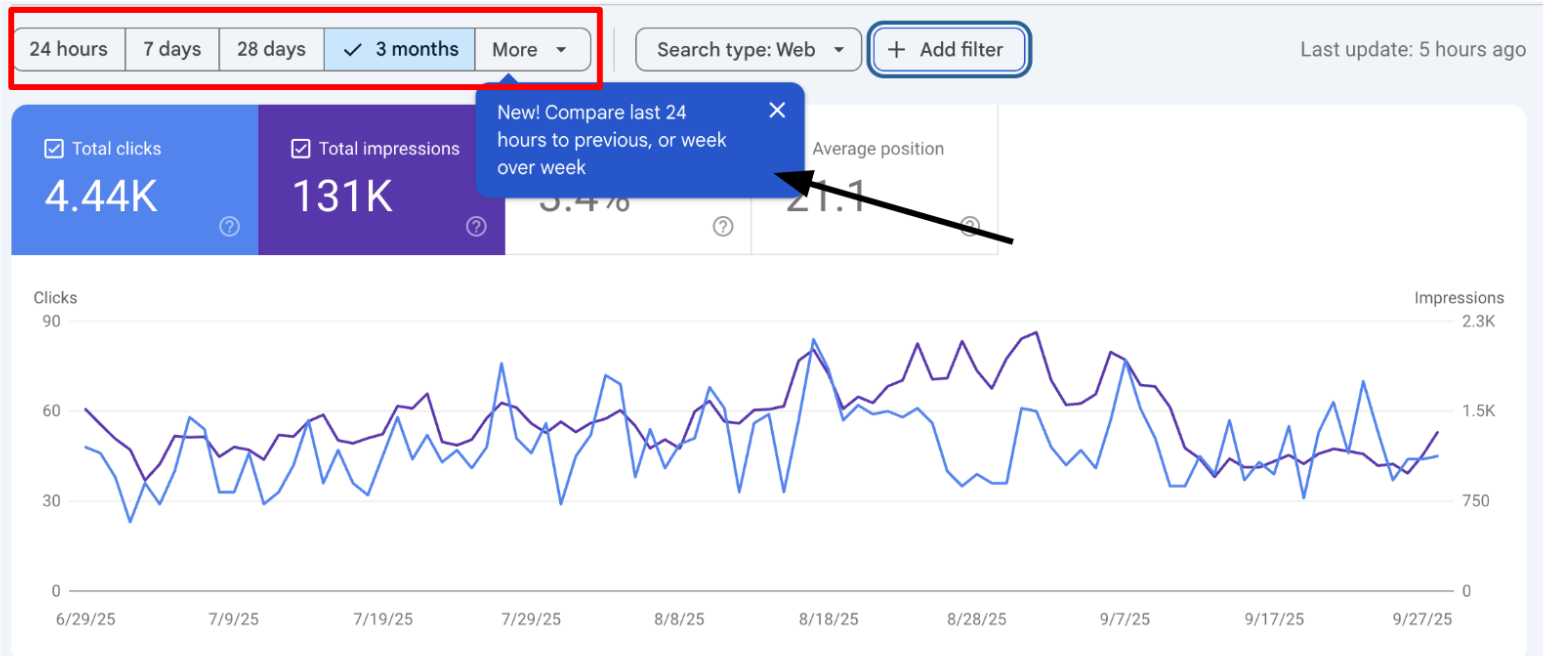
Then, click “add filter” and you can enter a few of your top branded search terms and see the impact:
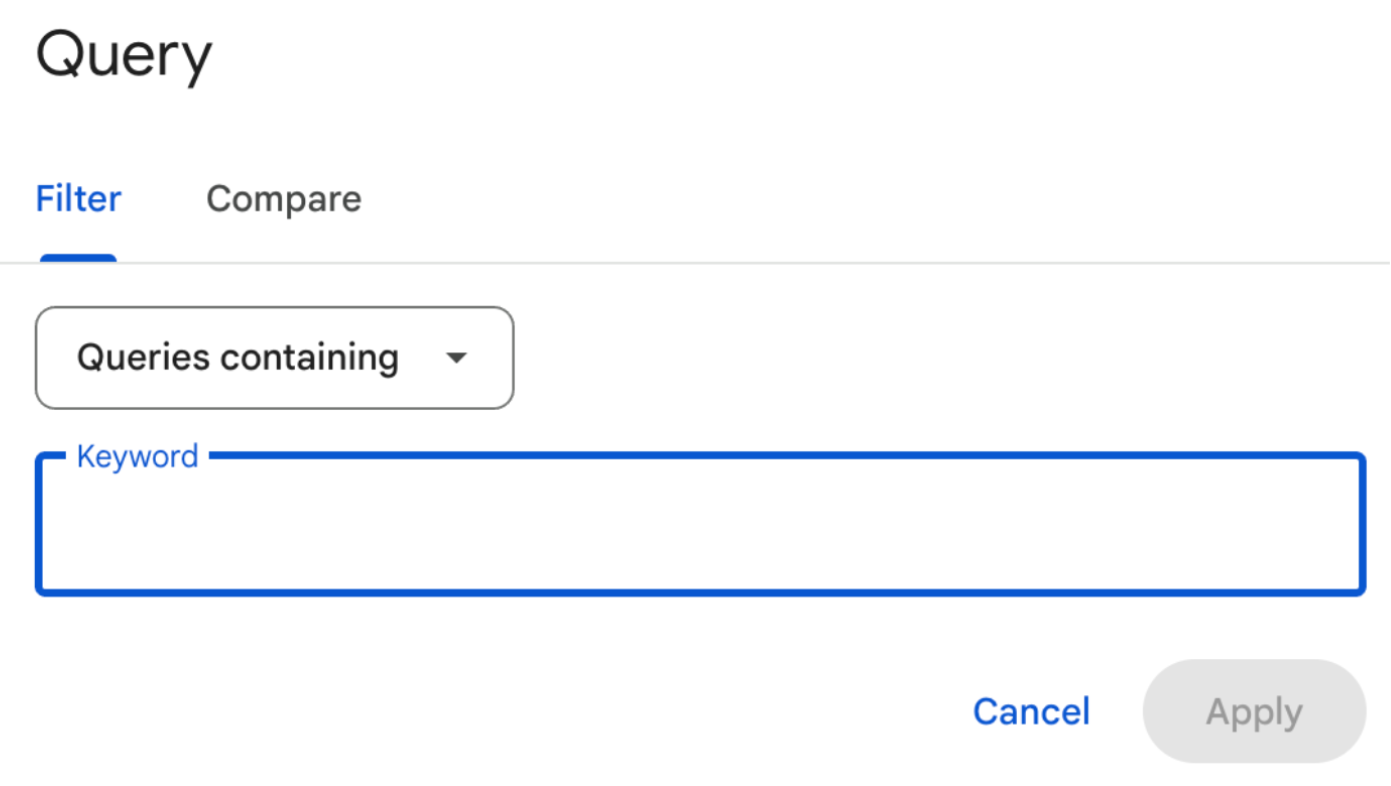
Most social media tools, like Hootsuite, BrandMentions, and others also provide an overview of brand mentions across the web. Or, you can set up a Google Alert to see specific mentions of your brand:

Clicks and Coupon Codes
You can track link clicks to influencer specific landing pages fairly easily, and coupon codes are a very easy way to attribute revenue to a specific influencer.
Adelė Grigūnaitė of Omnisend primarily uses coupon codes to track influencer performance.
“Right now our influencers offer 30% off for the first 3 months.”
However, she also confirmed that consumers don’t necessarily buy immediately, and it might take some time to see an ROI.
“In the email marketing niche, people don't migrate from their current ESP quickly. It takes time.”
In fact, Sarah Adam of Wix mentioned that she looks at not just the ROI from the first two weeks, but also the first 30 days and beyond:
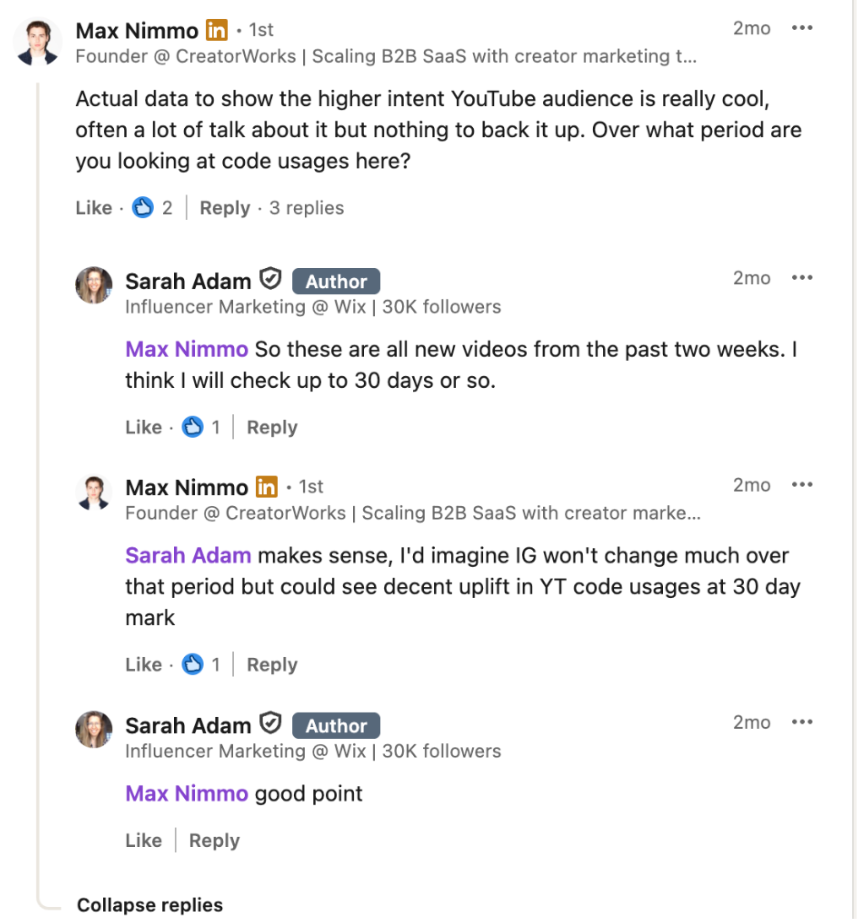
The evergreen nature of YouTube content is also another reason why YouTube is a prime channel for B2B influencer marketing, as these videos will continue to generate an ROI long after they were initially published.
However, getting customers to use the discount code can actually be quite challenging, especially if they decide to buy several weeks later (which is common in B2B).
This is a key reason why Jeremy Barbara’s data shows that code usage is significantly lower than attributed survey mentions:
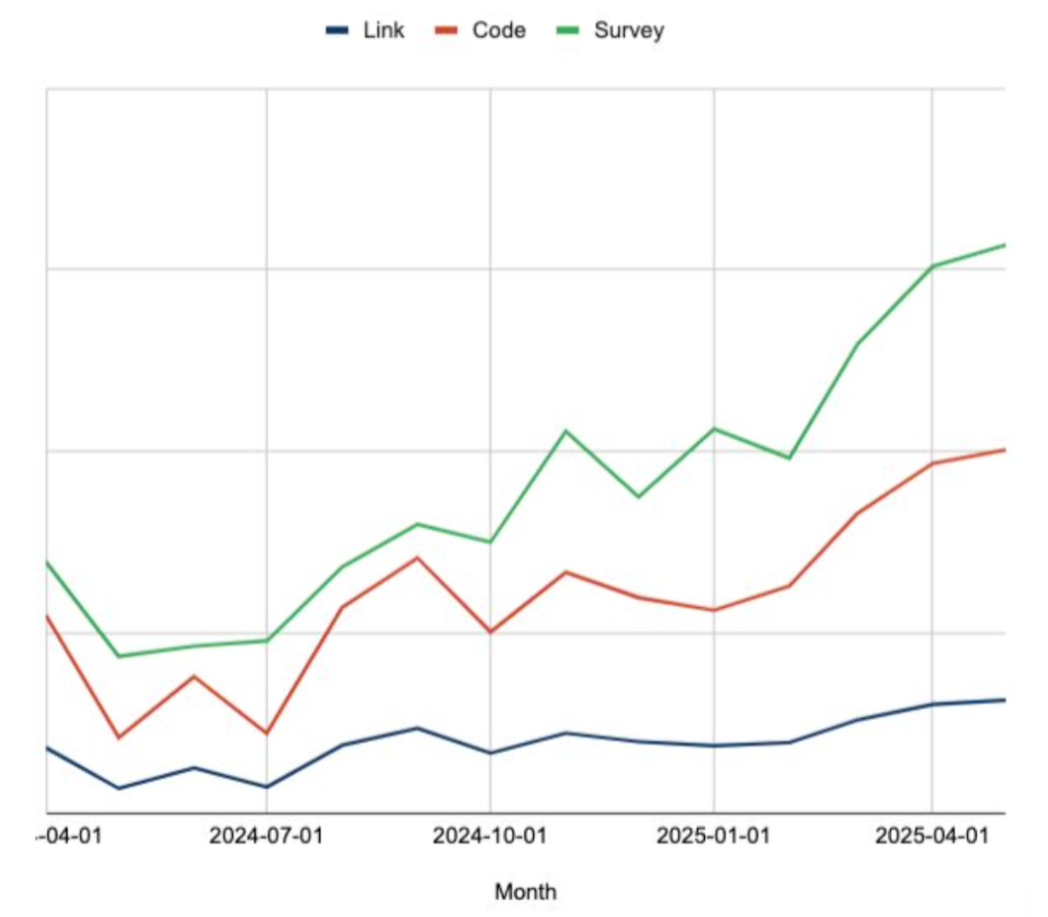
So how do you encourage people to use the discount code, and ideally, convert faster?
Sarah Adam mentioned that she saw best results if creators mentioned the discount code both verbally in the video and again in the description:
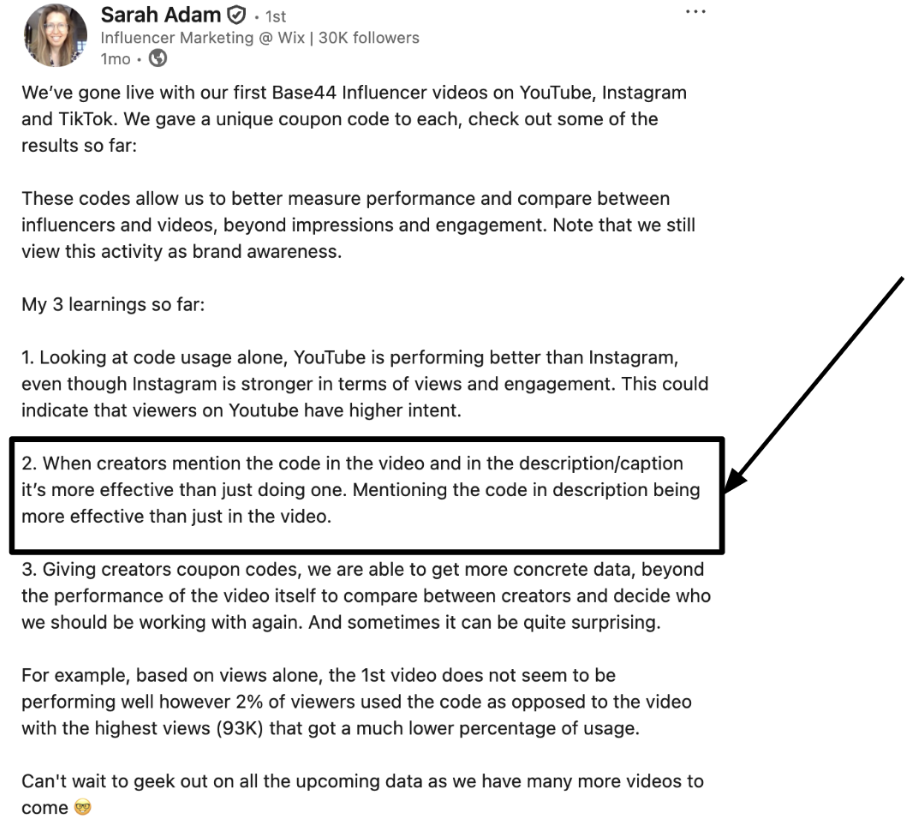
Jeremy of doola said that the best way to encourage people to use your promo code is leveraging creativity rather than simply increasing monetary incentives.
“Links, codes, these things are table stakes for tracking, but building attribution into the creative? That's how you align incentives and get free campaign tracking,” says Jeremy.
Jeremy explained that in one campaign with MrBeast, the incentive was MrBeast personally sending the audience member a dollar rather than providing a traditional coupon code.
Jeremy realized that the audience valued the personal transaction from MrBeast himself far more than a few extra dollars off their purchase.
While this is a unique example (and more relevant for B2C), Jeremy emphasizes that you can apply creativity to any campaign to encourage people to use the code.
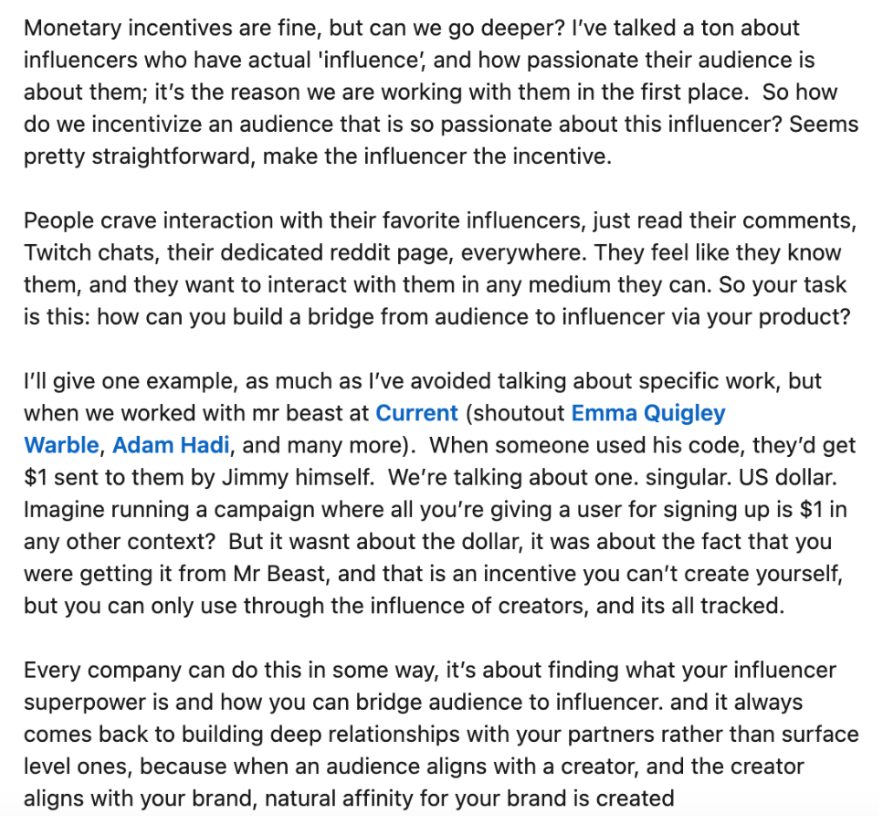
Coupon codes also allow you to tie ROI to specific creators, as views don’t necessarily correlate with revenue.
LLM Visibility and YouTube Search
According to a study from Semrush, YouTube is the third most cited source in LLMs. This means that the more mentions you receive on YouTube from influencers, the more likely you are to increase brand visibility in LLMs like ChatGPT.
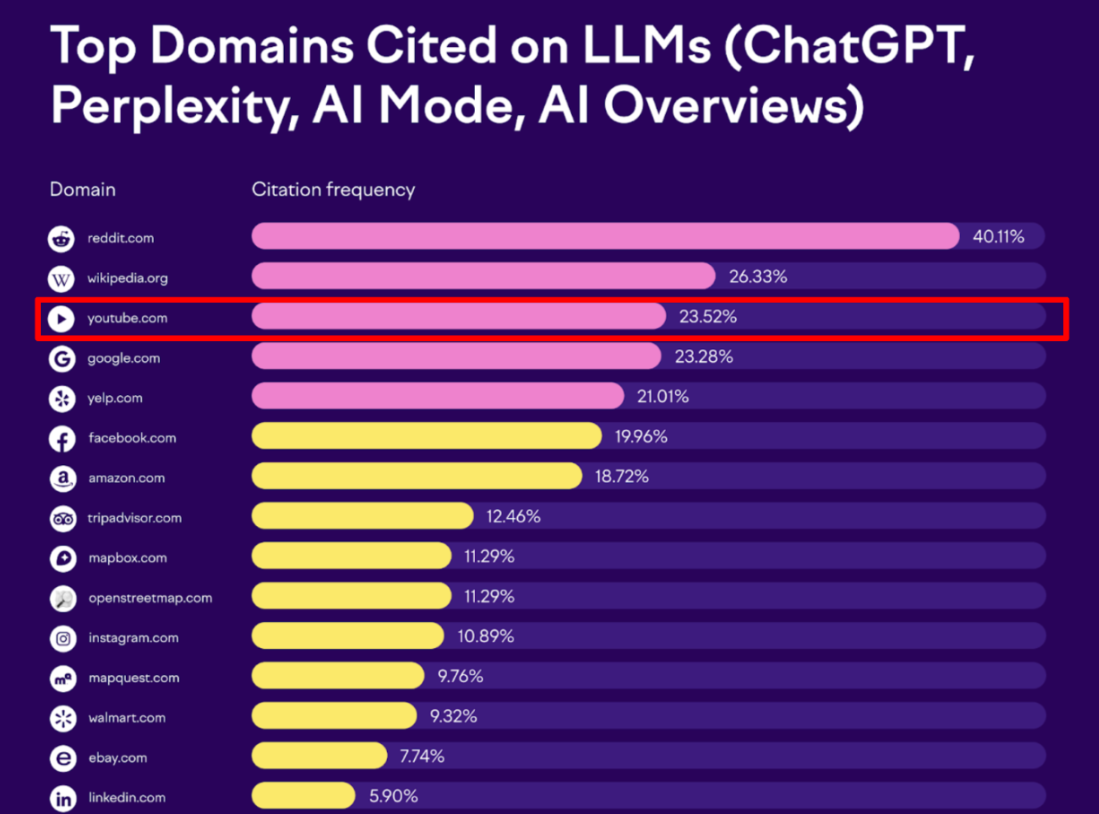
Ahrefs has more data to illustrate that earning more general mentions across the web significantly increases visibility in LLMs:
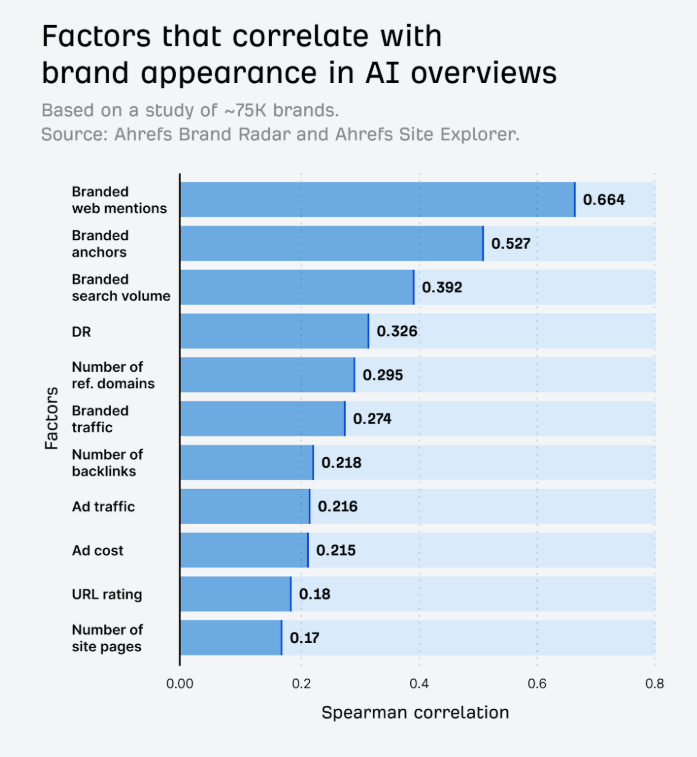
Therefore, to further justify your investment in influencer marketing to executives, start tracking LLM visibility.
You can also track traditional SEO KPIs, like keyword rankings for sponsored YouTube videos.
This is a critical KPI that Sarah Adam measures when evaluating the performance of Wix’s sponsored videos.
“We’re reaching out to YouTubers that are currently dominating top results for the target keywords we defined, on YouTube and also those that show up in relevant LLM search results and questions specific to our ICP and niche,” says Sarah.
She continues that this is how they’re tracking success from a tactical perspective:
“Instead of views, likes and comments, and tracking UTMs from the video description, we are now checking how the video is ranking on YouTube for the target keywords and LLMs for the target questions. This means manually checking, every week or so, whether or not these videos are appearing and for how long,” says Sarah.
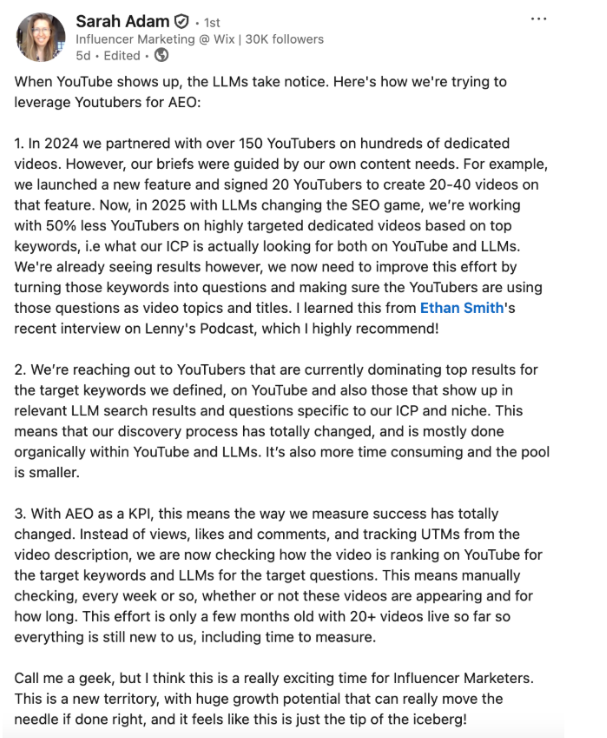
My recommendation is to put the URL of the sponsored YouTube videos into a tool like Ahrefs or SERanking and track the keyword rankings over time.
For example, here’s a video from Ali Abdaal titled “How to Build a Website:”
When I looked up the URL for this Ali Abdaal video in SERanking, it shows that this video ranks for all of these keywords:

It also shows me how often this shows up in AI overviews and LLMs:
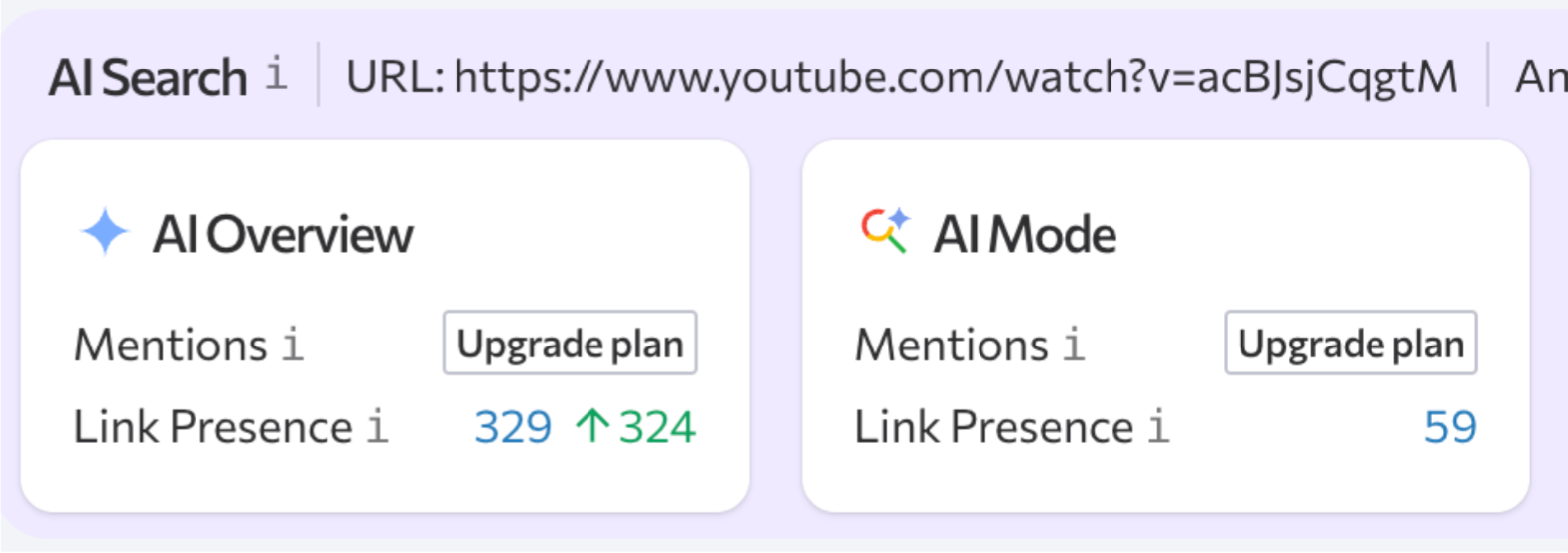
Check these stats for all of your sponsored videos to get an overview of the true impact of your sponsored videos on LLM and SEO visibility.
How Specific Influencer Marketers Are Measuring Their Influencer Marketing Campaigns
Each program has a slightly different method of tracking influencer marketing, so I thought I’d share how different influencer marketers measure ROI in their program.
Wix
Sarah Adam primarily uses coupon codes and impressions and engagement to measure the efficacy of Wix’s program:

Sarah cited keyword rankings for specific keywords for YouTube videos as another key KPI:

And, she mentioned that they measure success at two weeks, 30 days, and I’m guessing probably beyond as well.

Perspective
Alex Llull of Perspective says that they measure conversions and leads along with likes and impressions.

He elaborated in another post that he frequently creates a dedicated landing page for each influencer. If you have a long buying cycle or an enterprise product, consider offering a lead magnet.
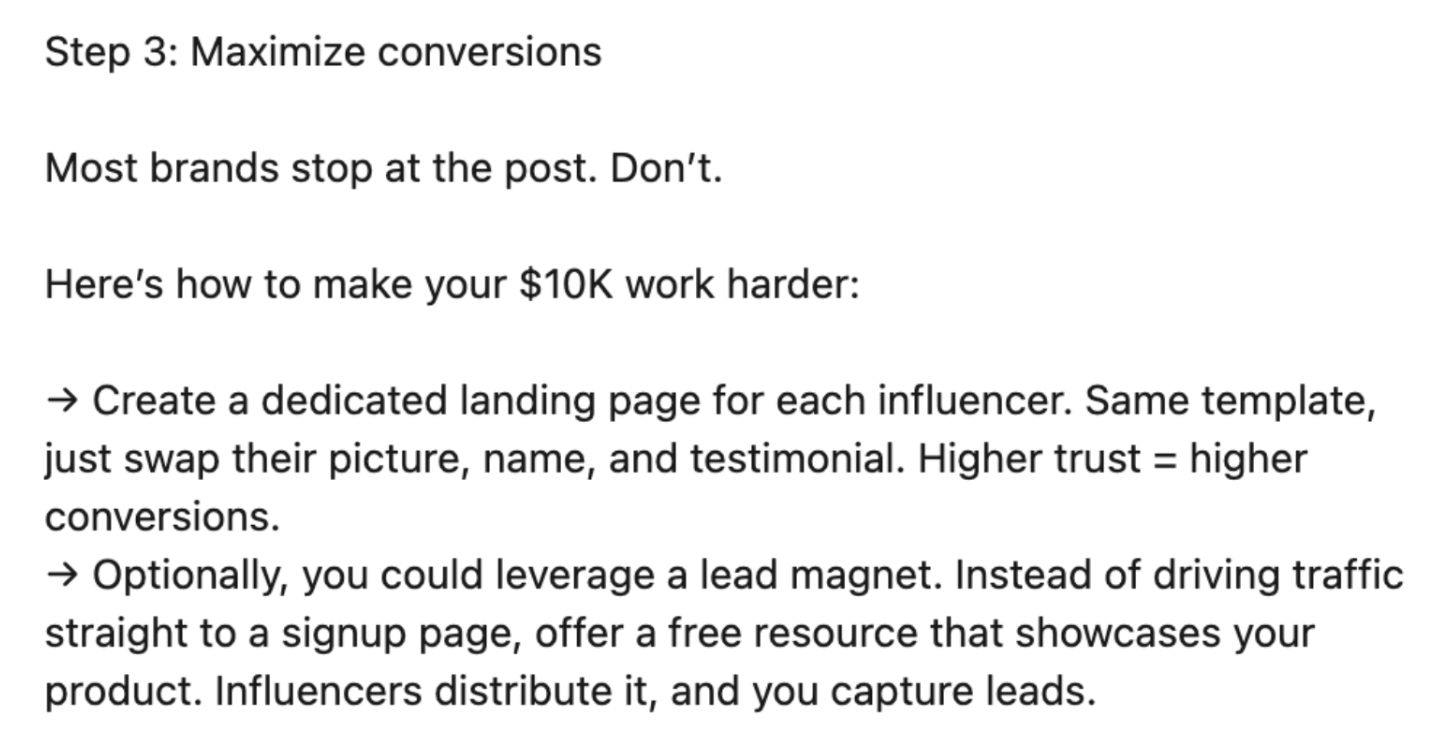
In fact, pitching a lead magnet was a critical lesson that the team from Ahrefs learned after they were seeing costs of over $1,290 per free trial sign-up from their initial influencer campaigns.
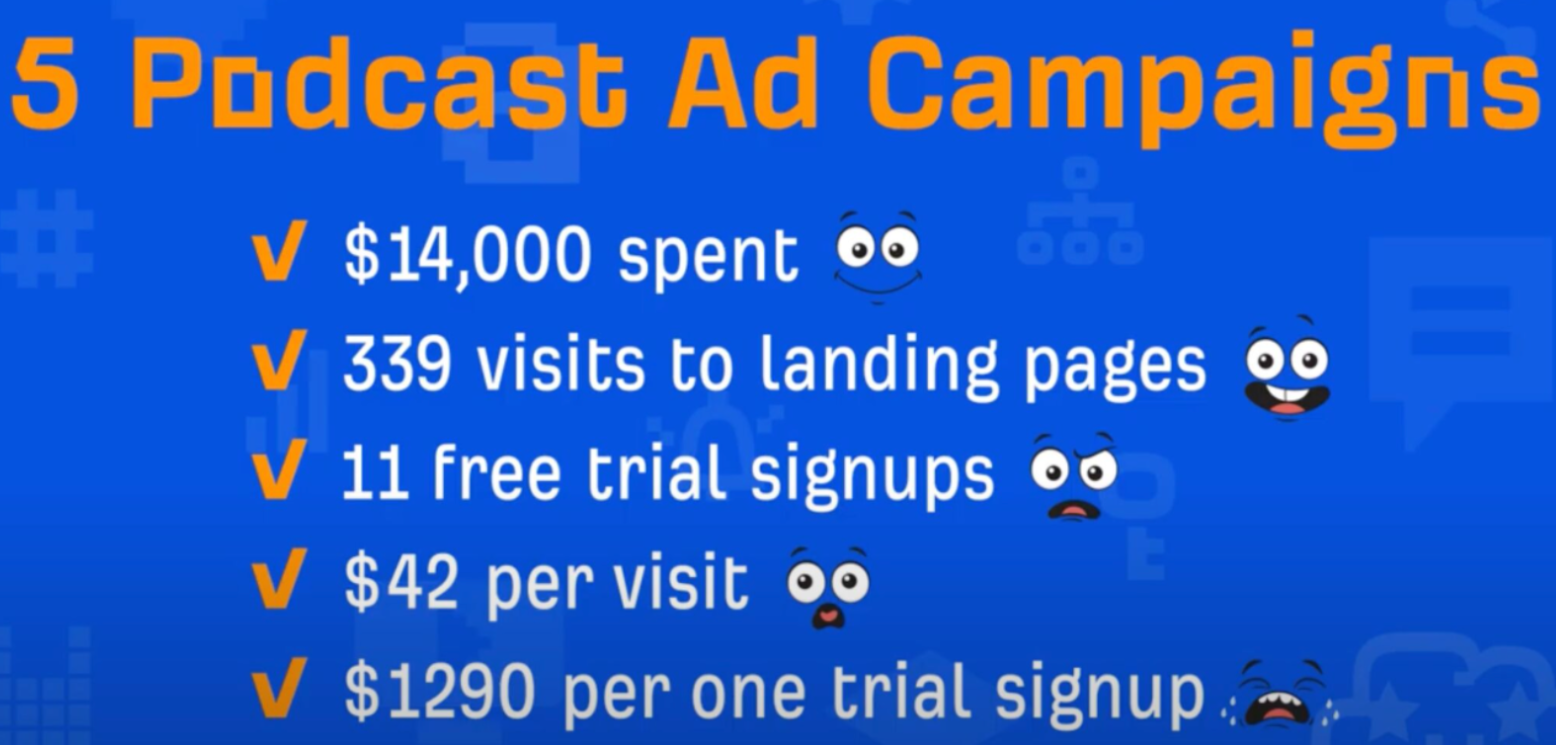
Storylane
At Storylane, they measure CPM, impact on brand searches, surveys, and post impressions:

Madhav Bhandari, their Head of Marketing, also shared that they look at pipeline correlation.
“...last month was our best month ever in terms of influencer impressions, and last month was our best month ever in terms of new MRR. I’ve gotten 1-2 verbal confirmations from sales that deals came through from a particular post, but that’s the extent of it.”

Therefore, ask your sales teams to also ask customers how they heard about your brand.
Omnisend
“Of course, you need to track the revenue coming from influencers,” says Adele.
At Omnisend, they offer a discount code to each influencer and track conversions.
“Right now our influencers offer 30% off for the first 3 months,” says Adelė.
Here’s an example of one of their landing pages.
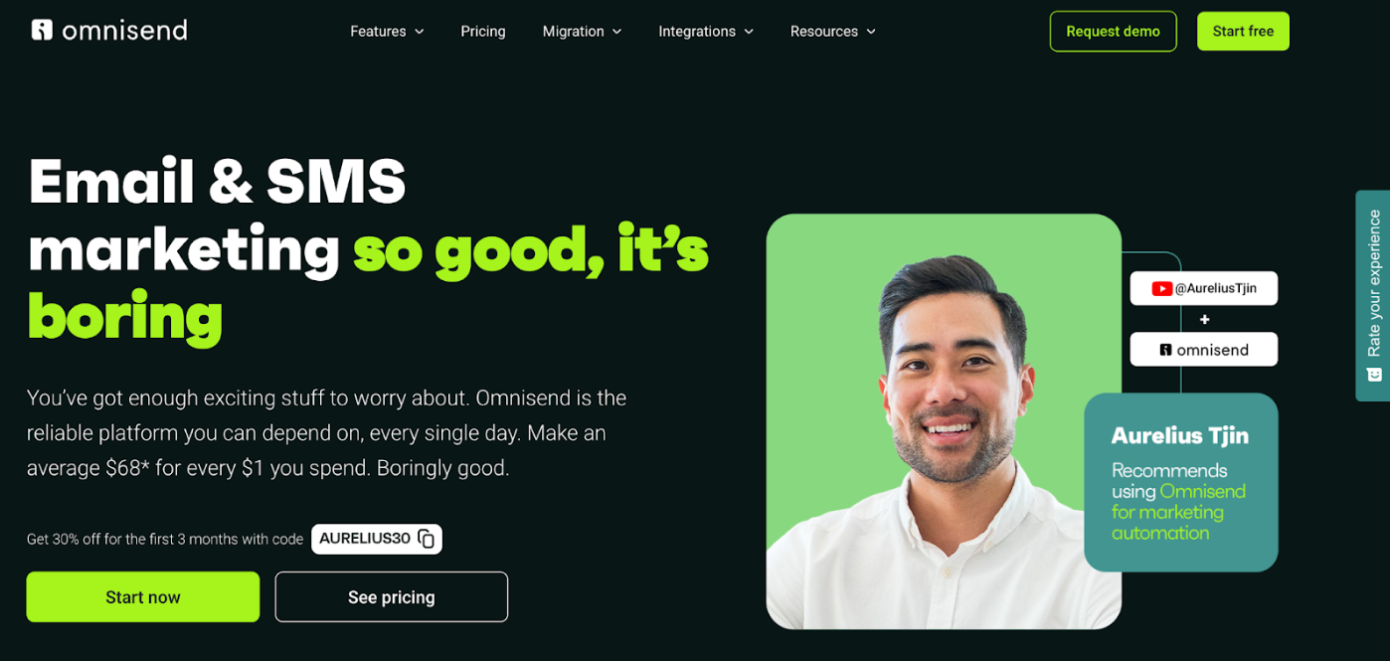
“For tracking platforms, we're on the Impact affiliate platform, and we have a great data team who created custom dashboards on Superset,” she says.
However, she also mentions that it’s important to track not just the immediate conversions, but also the conversion that might happen weeks or even months later.
“In the email marketing niche, people don't migrate from their current ESP quickly, it takes time. But when that happens, they might remember the discount code they should use.
She also does track views and engagement, but she emphasizes that it’s important to pair this with conversions.
“Speaking of misleading indicators, I would say that even though brand awareness is good to track views and engagement, sometimes influencers can reach audiences that aren't the same as who you're targeting.”
doola
I asked Jeremy of doola how they track influencer marketing, and here’s what he had to say:
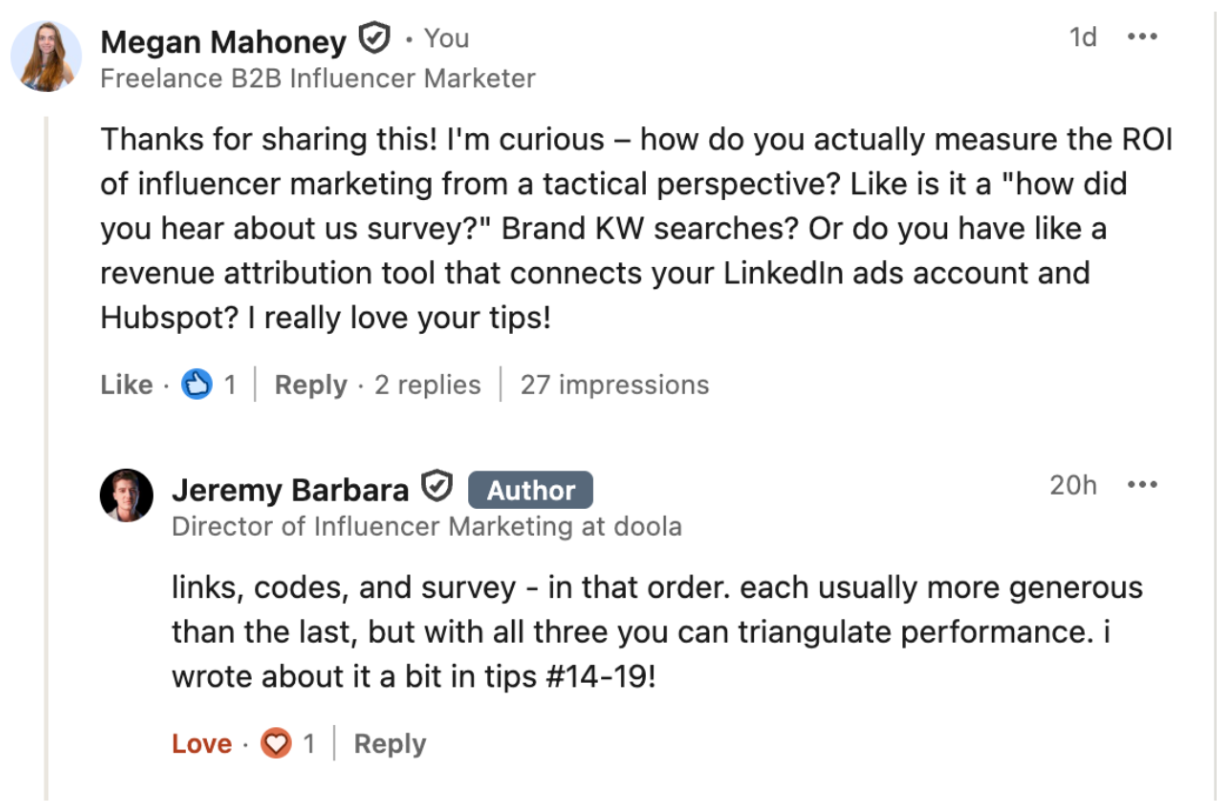
Mistakes Measuring The ROI of Influencer Marketing For B2B
If your influencer program isn’t performing as well as you want it to, here are a few of the most common reasons performance may be underperforming.
Not Giving it Enough Time
Influencer marketing takes time to work, especially if you have a longer buying cycle.
When I asked Adele of Omnisend how much time it takes, she said that ROI correlates with your buyer journey.
“It all depends on your customer journey. If you're in B2B, the path is longer, and one influencer promotion won't be enough to move the needle. But if you're in B2C where you trigger the impulse and desire to buy or install an application, then influencer marketing can start working right away.”
Therefore, measure the length of your buyer journey and then use that as a benchmark to measure performance.
However, realize that it will take some time to figure out what works and what doesn’t, so you might want to tack on another couple of months to allow for additional experimentation.
Grant Lee of Gamma recommends at least six months (and $10,000) to test influencer marketing and realize that most of your results will come from just a few campaigns:

Pitching a Demo/Free Trial Rather Than a Lead Magnet (For Enterprise)
Another key point the team at Ahrefs learned the hard way is that you’ll see very low conversion rates if you just offer a free trial or demo.
Instead, the Ahrefs team offers a lead magnet (their free Chrome extension):
“So, even for a company notorious for not measuring marketing ROI, we wanted to see some results. That’s why Igor settled on a sweet spot for all our creator campaigns: promoting Ahrefs Webmaster Tools (AWT).
AWT is a free version of Ahrefs that allows you to audit your website for technical SEO issues, shows who’s linking to you, and what keywords you’re ranking for. While not everyone needs a complex tool like Ahrefs, anyone with a website can instantly benefit from AWT.
It has everything we’re looking for in a campaign: it promotes our brand, showcases our product, and is free to sign up, making it an attractive offer.”
Of course, if you’re offering a coupon code, you can’t also offer a free trial or demo, so how do you pick one?
First, you can always test both options. However, a lead magnet is probably more advantageous than a coupon code if you’re pitching an enterprise product rather than a prosumer product.
It’s also important to consider the value of your lead magnet. If the lead magnet is just a guide, that probably won’t convert very well as it’s only minimally valuable and doesn’t demonstrate the value of your product.
However, if you have a Chrome extension or free version of your enterprise product that’s very valuable, use that as the main pitch.
Treating Influencers Like Paid Advertisers
Influencer marketing is a form of performance marketing, but it’s different from traditional paid ads because it has a larger impact on brand credibility and image.
You could spend $1 million on paid ads or $1 million to do a partnership with Selena Gomez.
You’d achieve reach and sales with both forms of advertising, but the partnership with Selena would have a far greater impact on your overall brand image and credibility.
If you only look at ROI from a conversion perspective, there’s a good chance that the paid ads would generate a higher immediate ROI, but the partnership with Selena Gomez might make the brand more memorable, credible, and increase existing customer loyalty.
Influencer marketer AJ Eckstein also echoed this:
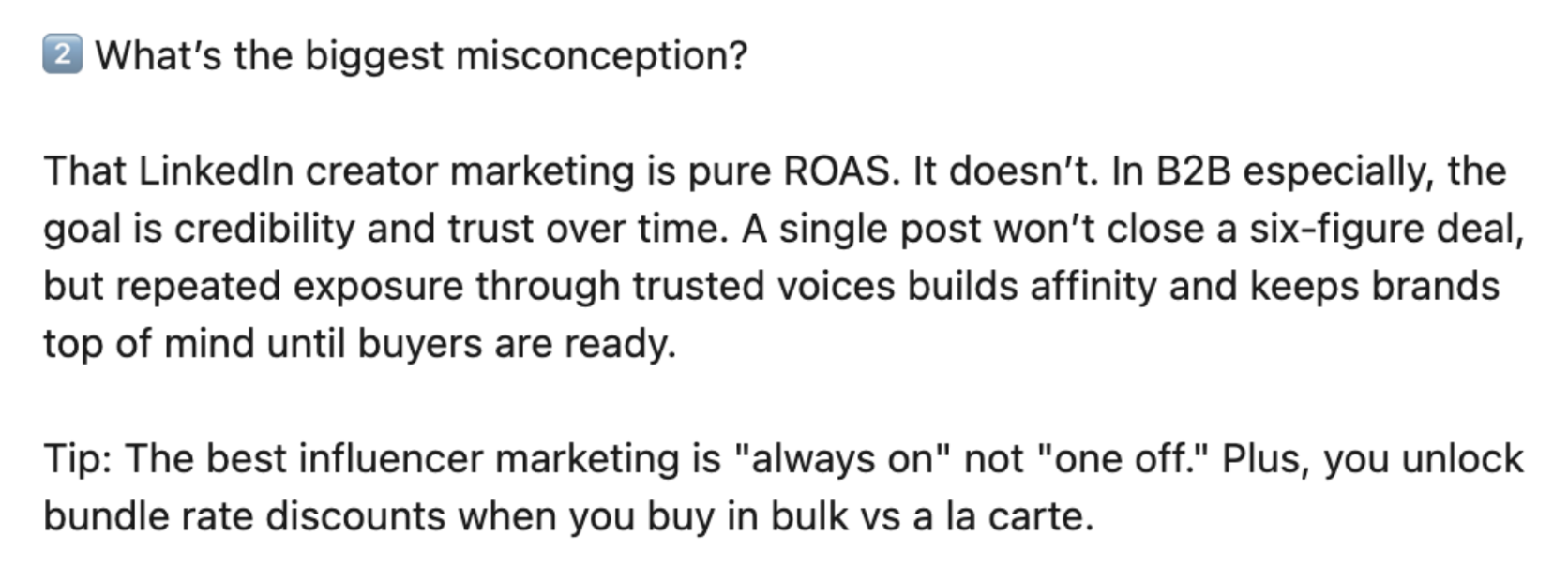
Branding factors are more difficult to measure, but one tip from B2B SaaS marketer, Dev Basu, is to look at your sales data and read through all of the closed-won and closed-lost reasons.
Then, track how the number of closed-won deals due to branding changes over time:
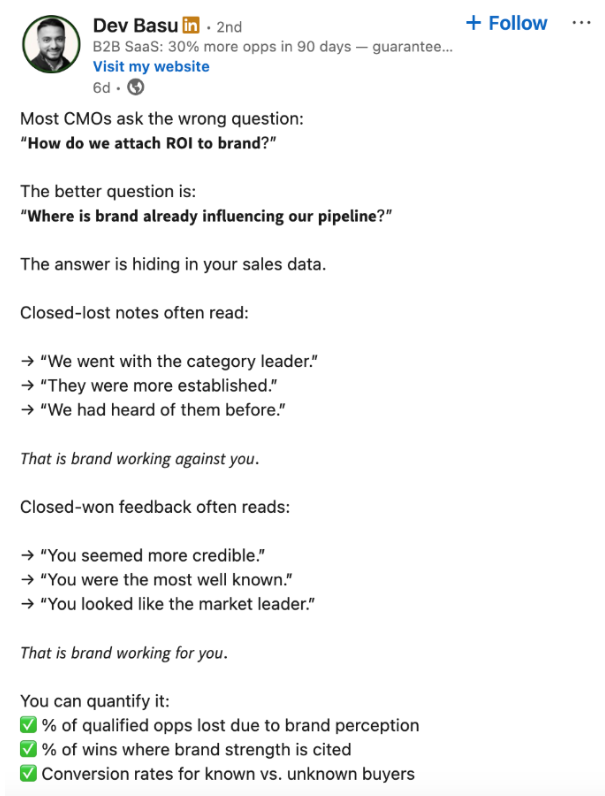
How to Further Improve the Efficacy of Your Influencer Marketing Program
One of the hardest elements of B2B marketing is finding the right influencers to partner with.
You’ll quickly find that manually searching for influencers is quite time consuming. This is why we built Favikon. It’s an all-in-on influencer marketing platform that allows you to find creators across YouTube, LinkedIn, X, Instagram, and other mainstream social media platforms.
And, instead of just filtering by follower count, you can filter by niche, average engagement, and other more granular metrics on specific platforms.
You can also manage your entire campaign inside the platform, from emailing or DMing influencers inside the platform to managing the creative process.
Check out Favikon today to find the right influencers for your campaign.
Related Articles
See all the articlesResources



.png)
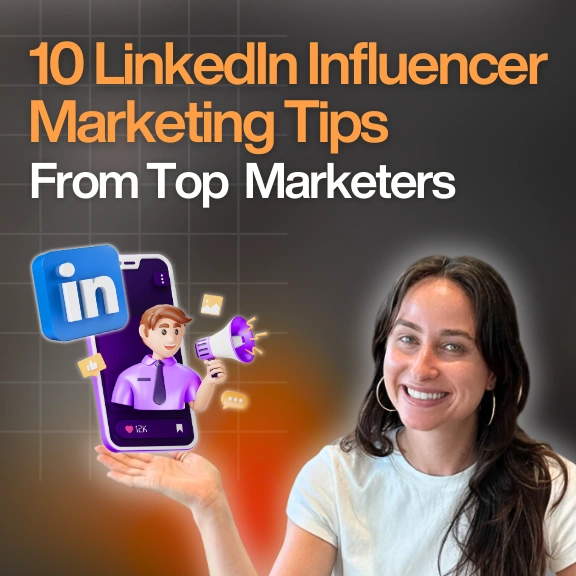
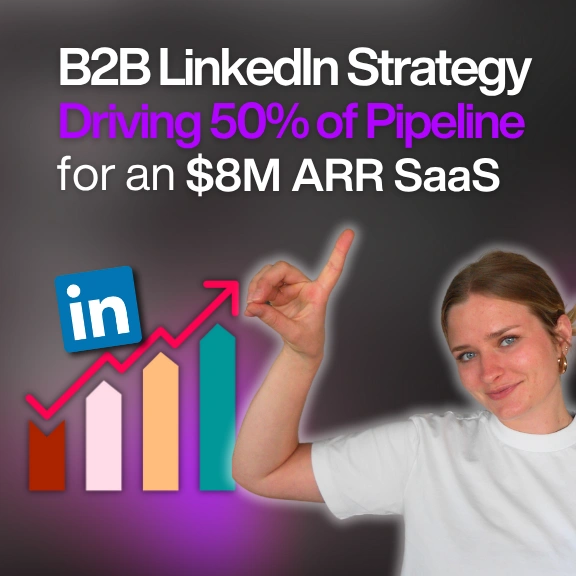




%20BANNER.webp)

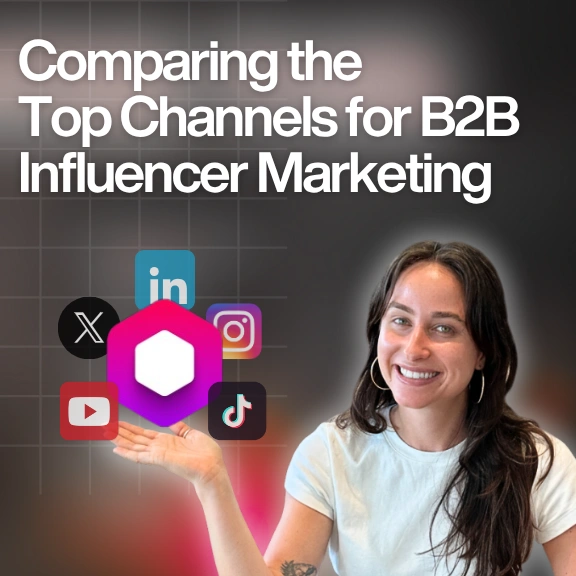

.png)
